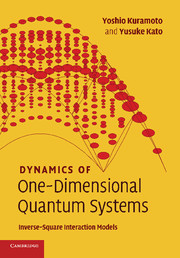Book contents
- Frontmatter
- Contents
- Preface
- 1 Introduction
- Part I Physical properties
- 2 Single-component Sutherland model
- 3 Multi-component Sutherland model
- 4 Spin chain with 1/r2 interactions
- 5 SU(K) spin chain
- 6 Supersymmetric t–J model with 1/r2 interaction
- Part II Mathematics related to 1/r2 systems
- Afterword
- References
- Index of symbols
- Index
6 - Supersymmetric t–J model with 1/r2 interaction
from Part I - Physical properties
Published online by Cambridge University Press: 12 January 2010
- Frontmatter
- Contents
- Preface
- 1 Introduction
- Part I Physical properties
- 2 Single-component Sutherland model
- 3 Multi-component Sutherland model
- 4 Spin chain with 1/r2 interactions
- 5 SU(K) spin chain
- 6 Supersymmetric t–J model with 1/r2 interaction
- Part II Mathematics related to 1/r2 systems
- Afterword
- References
- Index of symbols
- Index
Summary
A one-dimensional electron has both spin and charge degrees of freedom. In the limit of strong on-site repulsion, double occupation of a site can be neglected since it has a large energy cost. If the number Ne of electrons is less than the number N of lattice sites, vacant sites appear and the system acquires both spin and charge degrees of freedom. The simplest model to incorporate these degrees of freedom is called the t–J model, which is discussed in this chapter.
We begin by reviewing the SU(2,1) supersymmetry (SUSY) as an extension of the SU(2) symmetry in the spin chain. With the supersymmetry, the hopping and exchange in the t–J model can be treated in a unified way as the graded permutation. Then the ground state of the SUSY t–J model is derived in Section 6.2 by the coordinate representation of wave functions by using the fully polarized state as the reference. The static structure factor at zero temperature is completely determined by the wave function at the ground state. The spin and charge components are derived using the determinant and its generalizations in Section 6.3.
In Section 6.4, we proceed to derive the spectrum of the SUSY t–J model. The elementary excitations consist of spinons, holons, and their antiparticles. It is proved in Section 6.5 that these excitations span the complete set. The argument relies on a generalization of Young diagrams, which are called ribbon diagrams. At the same time, the degeneracy of energy levels beyond the global SU(2) symmetry is ascribed to the presence of a Yangian supersymmetry Y (sl2|1).
- Type
- Chapter
- Information
- Dynamics of One-Dimensional Quantum SystemsInverse-Square Interaction Models, pp. 233 - 308Publisher: Cambridge University PressPrint publication year: 2009

